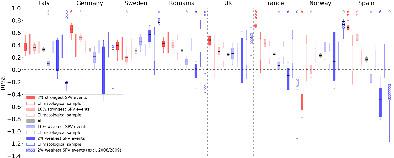当前位置:
X-MOL 学术
›
Q. J. R. Meteorol. Soc.
›
论文详情
Our official English website, www.x-mol.net, welcomes your feedback! (Note: you will need to create a separate account there.)
Stratospheric influence on ECMWF sub‐seasonal forecast skill for energy‐industry‐relevant surface weather in European countries
Quarterly Journal of the Royal Meteorological Society ( IF 8.9 ) Pub Date : 2020-07-06 , DOI: 10.1002/qj.3866 Dominik Büeler 1, 2 , Remo Beerli 2, 3 , Heini Wernli 2 , Christian M. Grams 1, 2
Quarterly Journal of the Royal Meteorological Society ( IF 8.9 ) Pub Date : 2020-07-06 , DOI: 10.1002/qj.3866 Dominik Büeler 1, 2 , Remo Beerli 2, 3 , Heini Wernli 2 , Christian M. Grams 1, 2
Affiliation

|
Meteorologists in the energy industry increasingly draw upon the potential for enhanced sub‐seasonal predictability of European surface weather following anomalous states of the winter stratospheric polar vortex (SPV). How the link between the SPV and the large‐scale tropospheric flow translates into forecast skill for surface weather in individual countries – a spatial scale that is particularly relevant for the energy industry – remains an open question. Here we quantify the effect of anomalously strong and weak SPV states at forecast initial time on the probabilistic extended‐range reforecast skill of the European Centre for Medium‐Range Weather Forecasts (ECMWF) in predicting country‐ and month‐ahead‐averaged anomalies of 2 m temperature, 10 m wind speed, and precipitation. After anomalous SPV states, specific surface weather anomalies emerge, which resemble the opposing phases of the North Atlantic Oscillation. We find that forecast skill is, to first order, only enhanced for countries that are entirely affected by these anomalies. However, the model has a flow‐dependent bias for 2 m temperature (T2M): it predicts the warm conditions in Western, Central and Southern Europe following strong SPV states well, but is overconfident with respect to the warm anomaly in Scandinavia. Vice versa, it predicts the cold anomaly in Scandinavia following weak SPV states well, but struggles to capture the strongly varying extent of the cold air masses into Central and Southern Europe. This tends to reduce skill (in some cases significantly) for Scandinavian countries following strong SPV states, and most pronounced, for many Central, Southern European, and Balkan countries following weak SPV states. As most of the weak SPV states are associated with sudden stratospheric warmings (SSWs), our study thus advices particular caution when interpreting sub‐seasonal regional T2M forecasts following SSWs. In contrast, it suggests that the model benefits from enhanced predictability for a considerable part of Europe following strong SPV states.
中文翻译:

平流层对欧洲国家能源行业相关地面天气ECMWF次季节预报技术的影响
能源行业的气象学家越来越多地利用冬季平流层极涡(SPV)异常状态后欧洲地表天气的亚季节可预测性增强的潜力。SPV和大规模对流层流之间的联系如何转化为各个国家的地面天气预测技能(一种空间规模与能源行业特别相关)仍然是一个悬而未决的问题。在这里,我们量化了预报初始时间异常强弱SPV状态对欧洲中型天气预报中心(ECMWF)预测国家和月份平均2异常的概率扩展范围重新预报技能的影响气温,10 m风速和降水。SPV出现异常状态后,就会出现特定的地面天气异常,与北大西洋涛动的相反阶段相似。我们发现,对于完全受这些异常影响的国家,预测技能只会得到一阶提升。但是,该模型具有2 m温度(T2M)的流量相关偏差:可以很好地预测SPV强状态之后西欧,中欧和南欧的温暖状况,但对斯堪的纳维亚半岛的温暖异常却过于自信。反之亦然,它预测了SPV弱状态后斯堪的纳维亚半岛的冷异常情况良好,但很难捕捉到进入中欧和南欧的冷空气量变化很大的程度。对于SPV强国之后的斯堪的纳维亚国家,这往往会降低技能(在某些情况下会显着降低),而对于SPV强国之后的中欧,南欧和巴尔干国家,这种趋势最为明显。由于大多数弱SPV状态与平流层突然变暖(SSW)有关,因此我们的研究建议在解释SSW之后的次季节区域T2M预报时应特别谨慎。相反,它表明该模型得益于SPV强国之后欧洲相当一部分地区增强的可预测性。
更新日期:2020-07-06
中文翻译:

平流层对欧洲国家能源行业相关地面天气ECMWF次季节预报技术的影响
能源行业的气象学家越来越多地利用冬季平流层极涡(SPV)异常状态后欧洲地表天气的亚季节可预测性增强的潜力。SPV和大规模对流层流之间的联系如何转化为各个国家的地面天气预测技能(一种空间规模与能源行业特别相关)仍然是一个悬而未决的问题。在这里,我们量化了预报初始时间异常强弱SPV状态对欧洲中型天气预报中心(ECMWF)预测国家和月份平均2异常的概率扩展范围重新预报技能的影响气温,10 m风速和降水。SPV出现异常状态后,就会出现特定的地面天气异常,与北大西洋涛动的相反阶段相似。我们发现,对于完全受这些异常影响的国家,预测技能只会得到一阶提升。但是,该模型具有2 m温度(T2M)的流量相关偏差:可以很好地预测SPV强状态之后西欧,中欧和南欧的温暖状况,但对斯堪的纳维亚半岛的温暖异常却过于自信。反之亦然,它预测了SPV弱状态后斯堪的纳维亚半岛的冷异常情况良好,但很难捕捉到进入中欧和南欧的冷空气量变化很大的程度。对于SPV强国之后的斯堪的纳维亚国家,这往往会降低技能(在某些情况下会显着降低),而对于SPV强国之后的中欧,南欧和巴尔干国家,这种趋势最为明显。由于大多数弱SPV状态与平流层突然变暖(SSW)有关,因此我们的研究建议在解释SSW之后的次季节区域T2M预报时应特别谨慎。相反,它表明该模型得益于SPV强国之后欧洲相当一部分地区增强的可预测性。


























 京公网安备 11010802027423号
京公网安备 11010802027423号